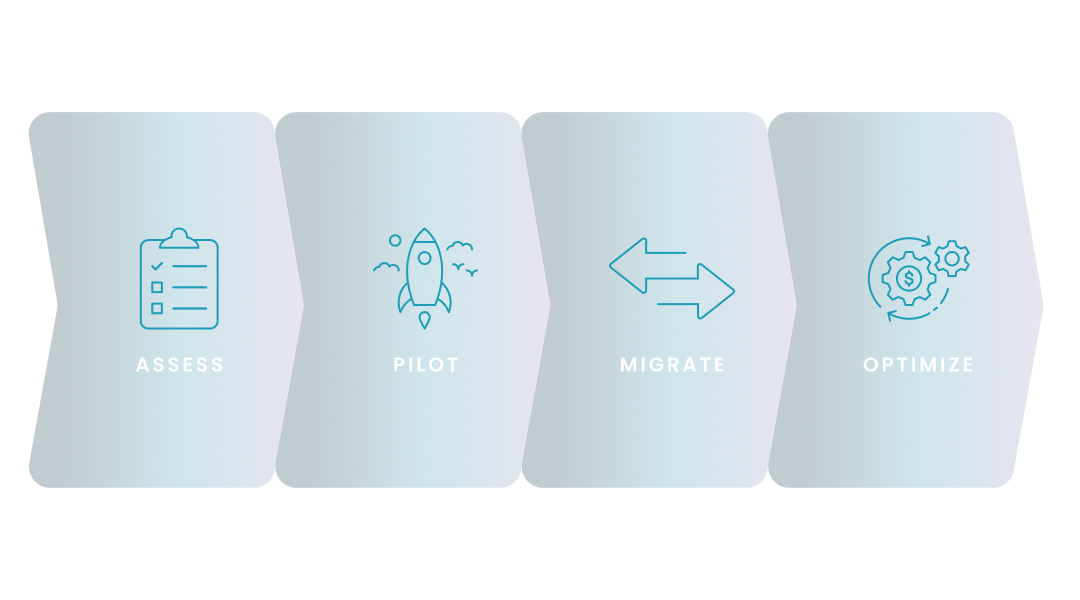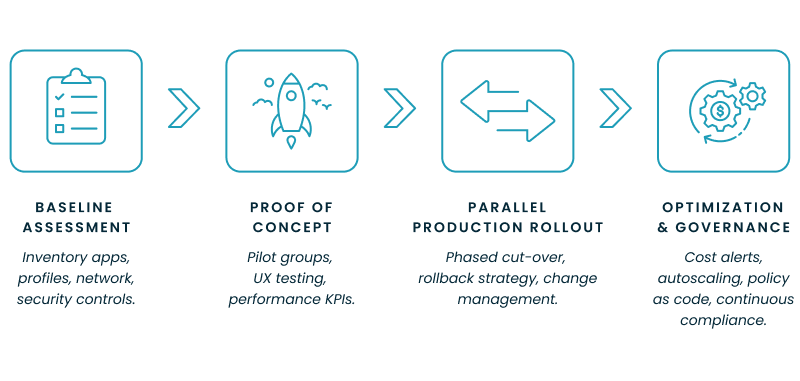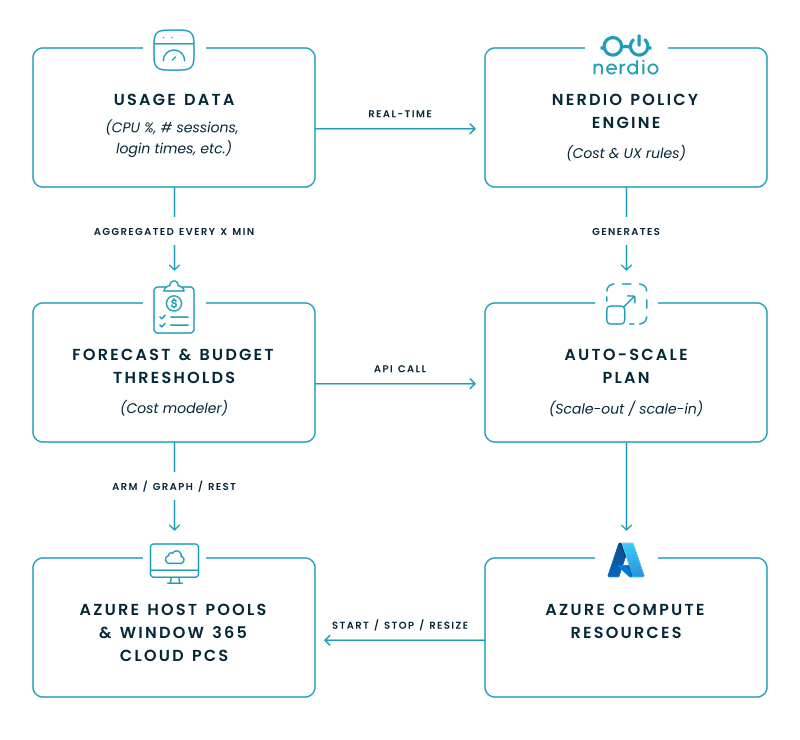Citrix Alternatives
This objective guide helps IT pros and business leaders understand why organizations outgrow Citrix, which modern VDI and desktop as a service (DaaS) options exist, and how to evaluate, compare, and migrate.

This objective guide helps IT pros and business leaders understand why organizations outgrow Citrix, which modern VDI and desktop as a service (DaaS) options exist, and how to evaluate, compare, and migrate.
Carisa Stinger | June 16, 2025
Organizations are considering alternatives to Citrix's on-prem and cloud-based DaaS solutions given reports of pricing increases, customer engagement restrictions, and restrictive renewal terms.
We’ll walk you through evaluation criteria, objective side-by-side comparisons, and a pragmatic migration roadmap so you can weigh top alternatives against your technical, budgetary, and user-experience requirements.
Disclaimer: Content referencing Citrix products is based on public information from the Citrix website, current as of the last article update. For the latest product details and further inquiries, please consult the official Citrix website.
Citrix DaaS provides application and desktop virtualization software, enabling users to remotely access and use applications and desktops hosted on central servers or in the cloud from any device. This technology delivers a unified digital workspace experience, improving flexibility and security for businesses.
| Category | Concerns 1 |
|---|---|
| Licensing cost & complexity | New “Platform” and “Universal” bundles replace à-la-carte SKUs, driving up spend and forcing annual commits |
| Contract rigidity | Reports of fixed terms and limited flexibility to adjust contract terms. |
| Shrinking community support | Termination of Citrix User Community Groups, less focus and outreach beyond the targeted list of existing customer accounts. |
| Security concerns | High-profile vulnerability where Local Privilege escalation allows a low-privileged user to gain SYSTEM privileges. |
Your short list shouldn’t start with product demos—it should start with a checklist. First pin down what your business needs, then test whether each contender can meet those needs at scale and within budget. The three buckets below keep proof-of-concepts focused and defensible when it’s time to brief your finance and security teams.
Business-level factors:
| Factor | What to Verify | Why It Matters |
|---|---|---|
| Commercial model | Subscription tiers, pay-as-you-go options, term-commit discounts | Subscription fees and licence bundling are a top driver for platform change decisions |
| Contract flexibility & SLAs | Ability to scale seats up/down, clear uptime credits, 24×7 support windows | Poor support or rigid terms can stall incident response and spike soft costs |
| Provider stability & roadmap | Public financials, recent mergers, cadence of feature releases | Stakeholders want assurance the platform will be maintained and innovated over multiple budget cycles |
| Data-sovereignty options | Choice of regions or sovereign clouds | Global organizations often require regional hosting for regulatory compliance |
Technical capabilities:
How end-user experience and IT visibility holds up in production:
| Metric | Recommended Target |
|---|---|
| Round-trip latency | < 150 ms for knowledge workers |
| Average login time | ≤ 30 s (boot-storm tested) |
| Input delay | < 100 ms under load |
| Session uptime | 99.9%+ with automatic reconnection |
Additional UX criteria:
Many organizations discover that “Citrix replacement” can mean very different things—from fully-managed cloud desktops to lightweight HTML5 gateways. Use the four categories below as a mental model before you start product shoot-outs.
We’ll start with a quick cheat sheet and then go into each in more detail.
| Category | Who Manages Control Plane? | Typical Billing Model | Best For |
|---|---|---|---|
| 1. Cloud DaaS | Vendor | Per-user / per-hour | Rapid scale, global reach |
| 2. On-prem / hybrid VDI | Customer | Annual subscription per user/per concurrent user | Data locality, custom integration |
| 3. App publishing | Customer (lightweight) | Per user/device or per concurrent user | Simple app access, cost control |
| 4. Special-purpose | Mix | Varies | VPN, secure browsing, high-GPU workloads |
Cloud DaaS are ideal when you need all-cloud delivery, elastic capacity, and Azure AD / AWS IAM hooks.
2. On-premises or hybrid VDI frameworks
As a foundational technology, VDI enables organizations to host desktop operating systems and applications on centralized servers, typically within their own datacenter and/or a chosen cloud, which can enhance data security and streamline IT management of end-user environments. These are best for tight data-sovereignty rules or when you already own hypervisor skills.
3. Remote Apps
These tools offer lean alternatives when you mainly need secure app access rather than full persistent desktops.
| Solution Style | Key Capability | Proof Point |
|---|---|---|
| Commercial all-in-one | Parallels RAS delivers a flexible virtual application and desktop delivery solution. | Single admin console, hybrid deploy |
| Open-source gateway | Apache Guacamole is a clientless remote desktop gateway supporting RDP, VNC, SSH through any HTML5 browser. | No agent on endpoints, community-supported |
Ideal for:
This approach can be good for targeted use cases—often graphics-heavy or security-isolated—that traditional VDI doesn’t cover well. Sometimes, the priority is enabling remote access to powerful physical workstations, not just delivering centralized virtual desktops and applications.
These tools usually sit alongside, not instead of, mainstream DaaS/VDI—e.g., engineers use CloudXR workstations while office staff remain on AVD.
Before you start a proof-of-concept, narrow your vendor list to options that answer your organization’s specific technical, budgetary and governance requirements. The five platforms below consistently appear in analyst notes and enterprise RFPs and have verifiable track-record data you can cite in a business case.
| Decision factor | Microsoft Azure Virtual Desktop (AVD) | Microsoft Windows 365 Cloud PC | Omnissa (VMware Horizon Cloud) | Amazon WorkSpaces |
|---|---|---|---|---|
| Delivery model | Customer-managed DaaS in your Azure tenant | Fully-managed Cloud PC SaaS from Microsoft | SaaS control-plane; desktops/apps run in your Azure (or other cloud/on-prem) subscriptions | AWS-hosted persistent (Personal) or non-persistent (Pools) desktops, fully managed |
| Stand-out strengths |
|
|
|
|
| Typical limitations |
|
|
|
|
| Public pricing snapshot* | Pay-as-you-go compute + storage + per-user RDS CAL; no fixed list price. | Fixed per-user monthly price (no metered compute) starting at US $28/user for 2 vCPU, 4 GB RAM, 64 GB Storage plan (pricing varies by region). | VMware quotes subscription price per user—varies by term/size (not publicly listed). | Example: Windows Standard bundle US $44 user/mo in US-West (AlwaysOn). |
| Best-fit scenarios | Organizations already standardized on Azure that want granular control over images and costs. | Fast Cloud PCs for hybrid work or seasonal staff when you don’t want to run Azure infrastructure. | Enterprises that need true hybrid/multi-cloud VDI but want VMware to run the control plane. | Distributed/global teams already in AWS wanting consumption-based pricing. |
| Decision factor | Azure Virtual Desktop | Windows 365 Cloud PC | Omnissa | Amazon WorkSpaces |
|---|---|---|---|---|
| Primary display protocol(s) | Microsoft RDP with UDP Shortpath & Entra-SSO | RDP Shortpath over TCP/UDP | Blast Extreme, optional PCoIP or RDP | NICE DCV (WSP) or PCoIP-compatible bundles |
| Multi-session OS support | Native Windows 10/11 multi-session pools | Single-user Cloud PC (can have non-concurrent multi-user to a single desktop instance with Frontline license) | Windows 10 Enterprise multi-session & Server RDSH on Azure edges | Single-user desktop per VM (no multi-session) |
| GPU / graphics instances | NV-, NVv4-, NVads-series GPU VMs; enable with supported drivers | Not yet GPU-enabled (road-mapped) | NV-series & NVadsA10v5 in Azure; GPU selectable during pod build | Graphics g4dn bundles with WSP in 12+ regions |
| FedRAMP High or equivalent | AVD in FedRAMP High scope for Azure Gov & commercial cloud | Covered under Microsoft Online Services compliance portfolio incl. ISO 27001, HIPAA, SOC 1/2/3 | FedRAMP High & StateRAMP High authorised control plane | FedRAMP-authorised regions available; requires FIPS endpoint & U.S. region selection |
| Identity & MFA options | Microsoft Entra ID (Azure AD), AD DS, hybrid & Conditional Access MFA | Cloud-only, hybrid or federated Entra ID with MFA/Conditional Access | AD-joined pods; True SSO, SAML & Azure AD federation supported | AWS Managed Microsoft AD, AD Connector, CAC/PIV smart-card MFA |
| Built-in autoscale / power management | Native autoscale plans (schedule or load) in GA | Capacity auto-managed by Microsoft (fixed per-seat price) | Advanced power-management policies for cost control on Azure nodes | AutoStop mode shuts down idle desktops; Cost-Optimizer can switch plans automatically |
| API / automation surface | ARM/Bicep, REST, PowerShell, Terraform | Microsoft Graph & Intune API | REST & PowerShell (Horizon Control-Plane API) | AWS CLI, SDKs, Cost-Optimizer CloudFormation |
| Published uptime SLA | 99.9% connectivity SLA (Microsoft Online Services) | 99.9% Cloud PC session availability | 99.9% monthly uptime for Horizon control-plane on VMware Cloud on AWS | 99.9% regional availability SLA |
This guide explains why AVD with Nerdio is the best answer to the Citrix challenge.
Moving off Citrix DaaS isn’t a single click—it’s a program. Microsoft’s Cloud Adoption Framework and TechTarget’s AVD migration playbook both recommend a four-phase approach: assess, prove, release, and optimize.

Use the checklist below to keep every stakeholder—security, networking, EUC ops and finance—aligned.
1. Baseline assessment – what must you inventory and map first
For many enterprises, their current Citrix on Azure deployment represented an initial step towards cloud-based virtual desktop infrastructure, often leveraging Azure's global footprint to extend familiar Citrix capabilities; understanding this existing environment is paramount when planning a migration.
2. Proof of value – how do you validate user experience and operations?
| Task | Success Metric | Reference |
|---|---|---|
| Deploy green-field host pool with minimal apps | < 30 min average login, ≤ 150 ms RTT | CAF PoC prerequisite |
| Re-point a pilot group’s profiles (FSLogix) to new storage | 100% profile load success | TechTarget migration tip |
| Capture operational runbook | Build image via pipeline; zero manual steps | TechTarget image-automation guidance |
Tip: keep Citrix production live while pilots run; compare user experience scores side-by-side.
Suitability & readiness—AVD and Windows 365 are now classed as enterprise-ready in Gartner’s 2023 DaaS Magic Quadrant.
Resilience concerns—AVD host pools can span 60+ Azure regions; hybrid fail-over is supported via Azure Stack HCI, and Nerdio simplifies cross-region DR set-up.
Cost doubts—Nerdio’s Auto-Scaling has shown up to 55% lower Azure compute spend than native AVD management.
Skills gap—Teams new to AVD can stand up a fully functional environment with Nerdio Manager in about two hours, versus days of native scripting.
3. Parallel production rollout – how do you cut over with minimal risk?
4. Optimization & governance – how do you stay lean and compliant after go-live?
This guide explains why AVD with Nerdio is the best answer to the Citrix challenge.
Many organizations discover that selecting an AVD or Windows 365 subscription is the easy part—the heavy lift is day-two operations. Nerdio Manager for Enterprise layers automation, cost-control, and policy tooling on top of Microsoft’s native services so you can deploy faster, run leaner, and satisfy audit teams without custom scripting.
Indeed, Nerdio Manager for Enterprise significantly streamlines both the initial azure virtual desktop setup and the process to deploy Windows 365, transforming these potentially complex tasks into automated workflows that rapidly deliver secure, user-ready virtual desktops and Cloud PCs with reduced administrative burden.

Nerdio ingests live session metrics, evaluates them against cost and performance policies, builds an auto-scale plan, and issues Azure or Windows 365 API calls that add, power down, or right-size machines.
| Capability | What it delivers |
|---|---|
| Policy-driven app deployment | Install or update apps across images, session hosts, or Intune devices from any repository. |
| FSLogix app-masking UI | Auto-discovers apps on a host pool and lets you assign access per user/group—no JSON editing. |
| Scripted Actions library | Built-in and custom PowerShell/Azure Runbook automations executed through a REST/GUI workflow. |
| Windows 365 licensing toolkit | Bulk-assign or reclaim Cloud PC licences, recently expanded in v5.x release. |
Tip: Drop the “gold-image rebuild” swim lane from your migration plan—Nerdio pipelines can rebuild and seal an AVD image with a single click.
By overlaying Nerdio Manager with AVD or Windows 365, you can shorten migration timelines, shrink cloud bills, and automate day-two tasks that typically bog down EUC teams.
See this demo to discover how you can simplify operations, enhance security, and lower the total Azure cost of your entire Windows 365 or AVD environment with Nerdio Manager.
See how you can optimize processes, improve security, increase reliability, and save up to 70% on Microsoft Azure costs.
No single platform is “best” for every organization, but analyst surveys show Azure Virtual Desktop (AVD) is the most widely adopted DaaS option, used by 62 % of enterprises, followed by VMware Horizon Cloud and Amazon WorkSpaces. Gartner’s buyer-ranked list of Citrix DaaS alternatives also puts AVD at the top, ahead of Horizon Cloud and AWS offerings. Your ideal choice should match your cloud strategy, licensing and user-experience targets.
Across both on-premises and cloud VDI, Azure Virtual Desktop (AVD) and VMware Horizon (now branded Omnissa) are the platforms most often positioned head-to-head with Citrix in analyst comparisons and buyer short-lists. Windows 365, with its fixed Cloud PCs, is also becoming part of these discussions for simpler cloud desktop needs.
Neither product is universally “better.” VMware Horizon suits organizations standardized on VMware ESXi but can introduce vendor lock-in, whereas Citrix Virtual Apps & Desktops supports a wider range of hypervisors and hybrid models. Evaluate factors such as existing hypervisor, hybrid-cloud plans, licensing, and required display protocols before deciding. Azure Virtual Desktop (AVD) presents another compelling option, especially for organizations heavily invested in Microsoft 365, while Windows 365 offers a simpler, fixed-configuration cloud PC experience
Gartner’s buyer-ranked “alternatives” list and other analyst round-ups most often surface these five enterprise contenders: Microsoft Azure Virtual Desktop, VMware Horizon Cloud (now branded Omnissa), Amazon WorkSpaces, Microsoft Windows 365 Cloud PC, and Parallels Remote Application Server (RAS).
The selection leans on Gartner’s and TechTarget’s evaluation data, focusing on vendors that (1) deliver full desktop or DaaS functionality at global scale, (2) rank highly in verified-buyer reviews, (3) offer broad compliance attestations (e.g., ISO 27001, FedRAMP) and multi-cloud or SaaS control planes comparable to Citrix, and (4) provide transparent licensing or pricing models that enterprise IT and procurement teams can benchmark.

Microsoft Azure Virtual Desktop

Nerdio Manager for Enterprise

Nerdio Manager for MSP

Carisa Stinger
Head of Product Marketing
Carisa Stringer is the Head of Product Marketing at Nerdio, where she leads the strategy and execution of go-to-market plans for the company’s enterprise and managed service provider solutions. She joined Nerdio in 2025, bringing 20+ years of experience in end user computing, desktops-as-a-service, and Microsoft technologies. Prior to her current role, Carisa held key product marketing positions at Citrix and Anthology, where she contributed to innovative go-to-market initiatives. Her career reflects a strong track record in driving growth and adoption in the enterprise technology sector. Carisa holds a Bachelor of Science in Industrial Engineering from the Georgia Institute of Technology.